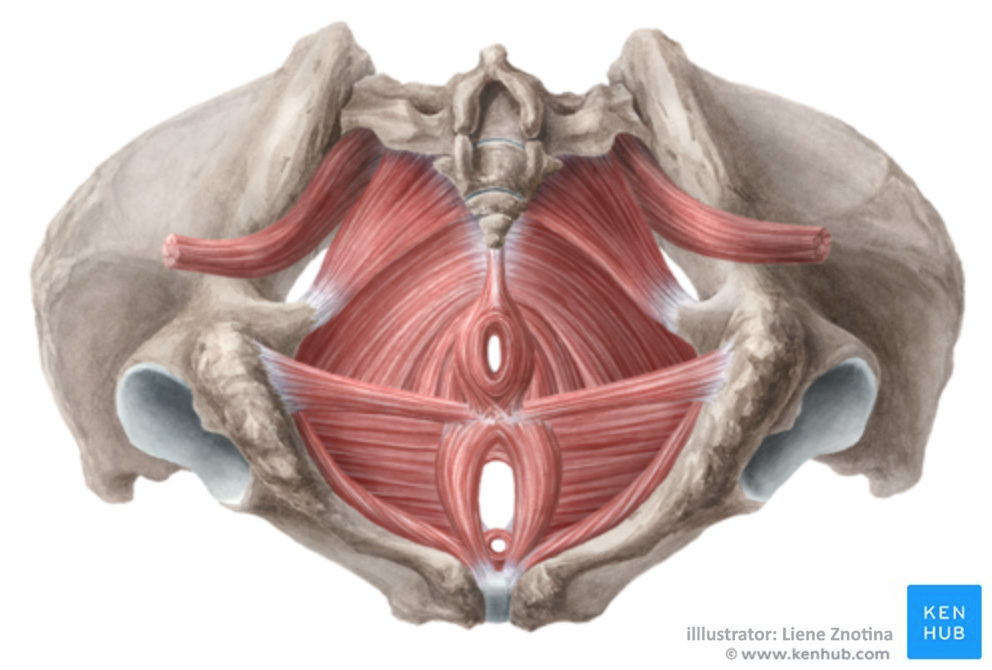Pelvic floor exercises - Mommy Body Bliss Series
Spoiler alert: The remedy for improving your pelvic floor function and healing incontinence often lies far beyond an isolated Kegel exercise!
Knowing the Basics
Exercises to strengthen pelvic floor - Female pelvic floor muscles - Bottom view - Used with permission from ©Kenhub.com
As we saw last time, the pelvic "floor" is an appropriate name because it’s situated at the bottom of the pelvis, and closes off the opening that would otherwise allow the pelvic and abdominal contents above it to fall through! It’s a system of muscles, ligaments, tissue, and nerves that form a support for your bladder, uterus, and bowel. (click here to read more about pelvic floor muscles function)
Note that even if you can’t see your pelvic floor, you can consciously control and exercise those muscles, just as you would any other muscle.
Women’s pelvic floor
How to strengthen pelvic floor - Female deep pelvic floor layer - Top view - Used with permission from ©Kenhub.com
As women, our pelvic floor is weaker than men’s because ours is pierced by the vagina. Plus, our pelvic floor is subjected to much more stress, especially during pregnancy and childbirth. Once becoming a Mother, regardless of how you gave birth, your chance of developing urinary incontinence increases. Your whole core needs to be re-strengthened with postnatal exercise, and then proper functions need to be maintained.
Healthy pelvic floor function is the foundation for your entire core.
Including pelvic floor muscle exercises in your daily routine helps prevent and manage incontinence, reduces the risk of prolapse, and can make sex more pleasurable. Pelvic floor exercises can also help to alleviate postpartum back pain and achieve flatter abs if done correctly!
The origin of Pelvic Floor Exercises
The famous “pelvic floor exercises” known as Kegel exercises were developed by Arnold Henry Kegel in the late 1940s. It was a huge step forward at the time because it was the very beginning of pelvic floor rehab after birth. He developed a tool to measure the strength of the pelvic floor muscles' voluntary contractions during "kegel exercises", aka vagina squeezes.
There wasn't any mention of the length of the pelvic floor or its relationship with breathing. He was just evaluating the strength of the pelvic floor muscles. It was a great start, but today, it's proven that a strong pelvic floor isn't automatically a healthy pelvic floor.
Let's purposely move away from the idea that to improve our pelvic floor function, we need to isolate the pelvic floor muscles. That’s not how the core system works; that's not how our BODY works!
Pelvic Floor Exercises
Where to start?
Core muscles - pelvic floor exercises
The pelvic floor muscles are part of a system that includes the diaphragm (at the top), pelvic floor (at the bottom), deep abs (on the front and sides), and spinal stabilizers (in the back)
In real life, these muscles work together as a team, never in isolation.
Pelvic floor exercises start with proper breathing! Our breath is what connects our whole core: pelvic floor, diaphragm, deep abs, and back muscles.
I often receive questions such as “How to do Pelvic Floor Exercises?” or “How to strengthen pelvic floor muscles?” Well, to begin, it’s essential to think beyond the idea that we simply need to contract and release the pelvic floor muscles to improve their function.
Some women are so committed to strengthening their pelvic floor that they try to squeeze as hard and long as they can. Some hold their breath while squeezing, and some develop a hypertonic pelvic floor... More imbalances develop.
Thinking pelvic floor exercises the Holistic way!
The biggest issue is often a lack of pelvic floor knowledge, a lack of muscle coordination, a lack of CORE CONNECTION and awareness. Not merely a lack of ‘strength’.
Instead, we need to train the whole core system to function and sync to meet the demands of our activities and daily life.
By focusing on every core element and form, my breathing techniques can restore and maintain a strong and functional core, able to handle the demands of a fully lived LIFE.
Pelvic floor exercises + Lose the Post Baby Belly - Core Rehab
How to do Pelvic Floor Exercises
When using the correct breathing technique, ANYTHING can become a pelvic floor exercise!
The goal is to enhance the relationship between core elements to balance and rebuild strong and functional foundations.
Even at rest, our breath connects everything:
When we take a breath in, the diaphragm descends. Simultaneously, the pelvic floor lowers, and our tummy expands a little bit to receive the abdominal content.
The pelvic floor and your deep abdominal muscles are stretched during the inhale, a little bit like a rubber band. They have elasticity, and they will both rise on the exhale to help stabilize the spine and pelvis.
So when using specific breathing techniques in your exercises, you can take the inner core work to the next level, develop better brain/body connection and better function overall!
In the beginning, a core rehab journey should start with pretty static exercises to minimize the coordination needed, master the core breathing technique I teach you in my online programs, and focus on rewiring your brain and inner core muscles.
But after a few weeks, the inner core training should include more full body and functional moves. When using the correct breathing technique, ANYTHING can become a pelvic floor exercise!
Let's thrive for function and develop harmony in this core system!
Pelvic floor exercises - Monthly Workout Plans for Busy Moms (Post Core Rehab)
Make Pelvic Floor Exercises a Routine
Every little bit helps!
People, in general, often lack pelvic floor and breath awareness. The beginning of a core rehab journey may be challenging. The breathing techniques are new, you’re aren’t sure about your form, it forces you to slow down and tune in, your brain may fight it… But the more you practice, the more awareness, connection, and activation you’ll develop.
Women do not have to live with pelvic floor issues just because they became Mothers. Most of us can make huge improvements and regain ab and pelvic floor muscles function by performing regular pelvic floor muscle exercises. Pelvic floor exercises should be part of our daily life, whether it’s to improve or maintain healthy functions!
Knowledge and raised awareness about the pelvic floor, breath, and alignment are key to preventing and/or improving pelvic floor function issues.
pelvic floor exercises
Improve and even prevent pelvic floor issues
Live an active pain-free life - Strengthen pelvic floor
Regular daily pelvic floor exercises can improve and even prevent urinary incontinence.
Sadly, out of embarrassment, shame, or fear, too many women give up doing what they love and try to ignore symptoms as long as they can before seeking help becomes unavoidable.
It’s time to give our pelvic floor and breathing the attention they deserve and acknowledge their fundamental role to live an active, leak-free, and pain-free life to the fullest!
Pelvic floor muscle problems are diagnosed by specially trained Doctors and Physiotherapists using internal and external “hands-on” or manual techniques to evaluate the function of these muscles.
Please remember that I offer online fitness programs. They should not be used as a substitute for hands on personal attention from a Doctor or Physical Therapist







